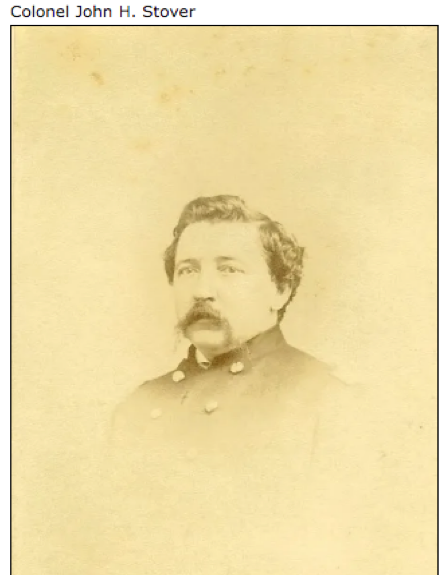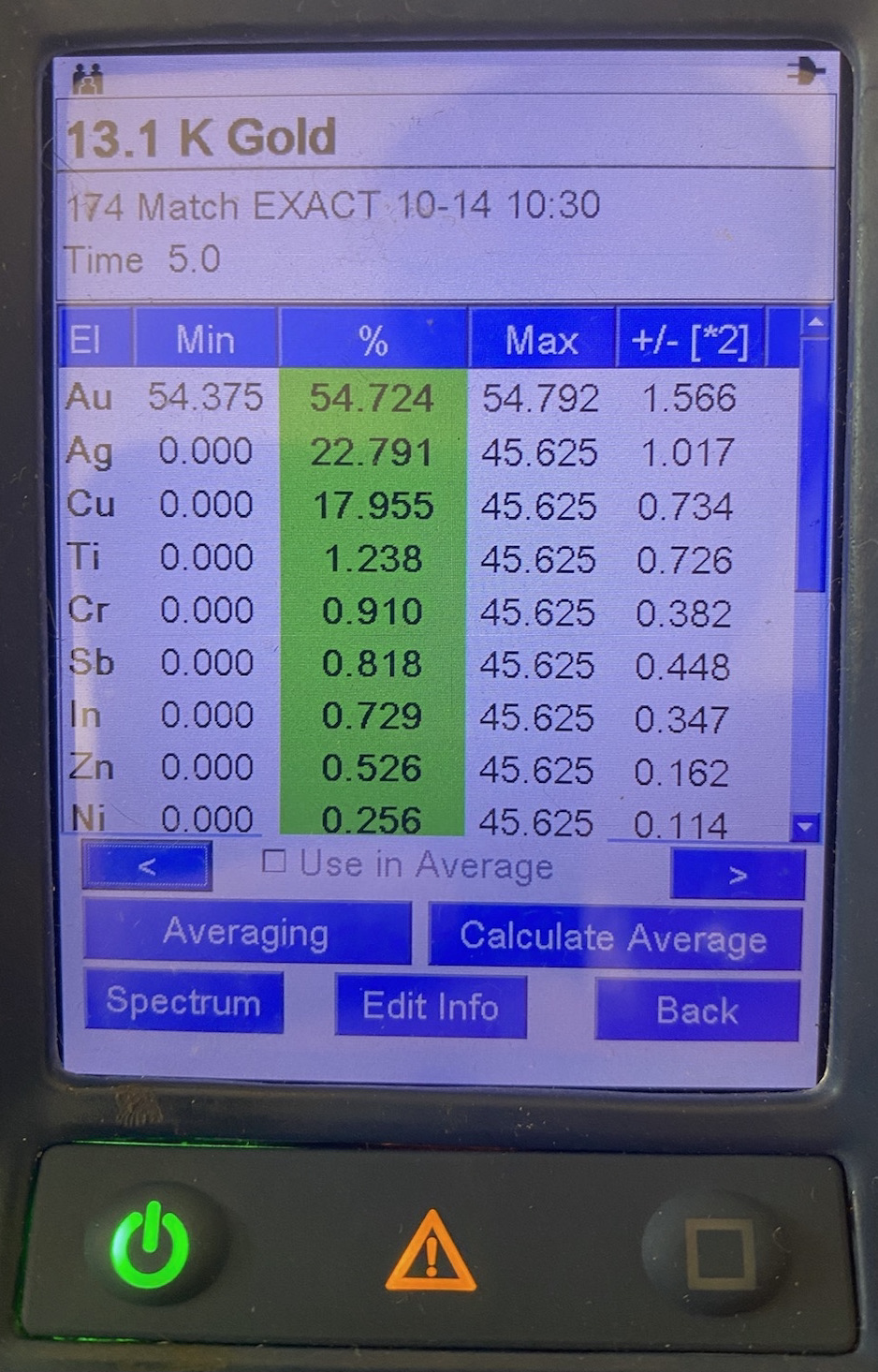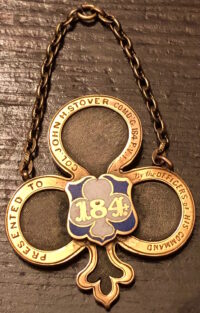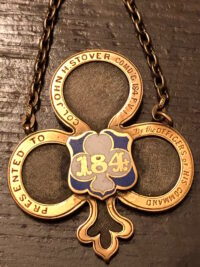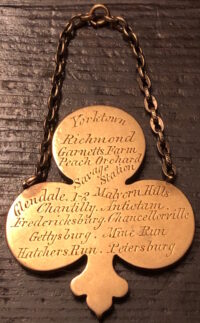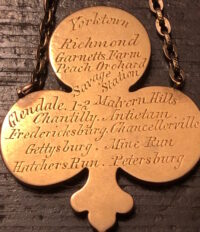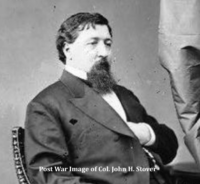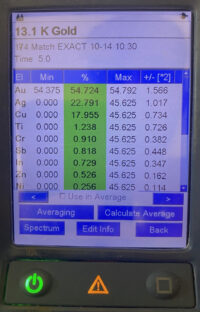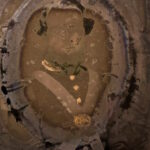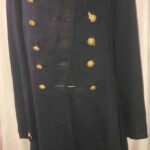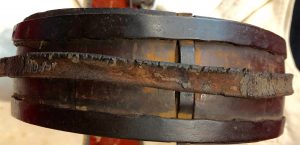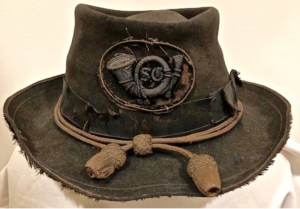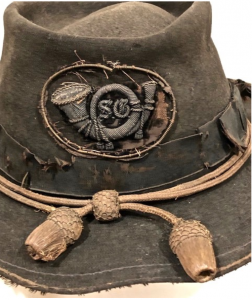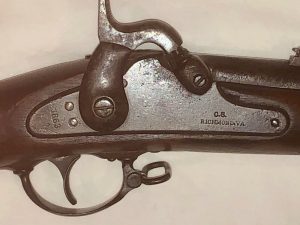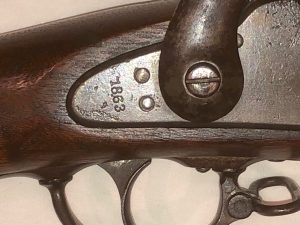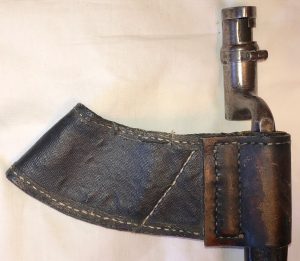Fine Gold Presentation 2nd Corps Badge Presented to Col. John H. Stover, 184th Pa. Infantry, Twice WIA
SOLD
Fine Gold Presentation 2nd Corps Badge Presented to Col. John H. Stover, 184th Pa. Infantry, Twice WIA – This finely crafted, enameled, gold** 2nd Corps badge, was presented to Col. John Huble Stover by the officers of his regiment. Engraved on the leaves of the trifoliate badge is the following:
“PRESENTED TO
COL. JOHN H. STOVER COMD’G 184 P.V.I.
By the OFFICERS of HIS COMMAND”
In center of the badge, a gold, enameled shield bears the gold inlay numbers “184”; the surrounding blue and off white field, around the regimental number, indicates that Stover’s regiment was part of the 3rd Division. The interior surface of each of the exterior side of the leaves of the badge, is stippled and enameled brown, as is the stem. On the reverse side of the badge is engraved a series of significant battle honors:
“Yorktown
Richmond
Garnetts Farm
Peach Orchard
Savage Station
Glendale 1-2 Malvern Hills
Chantilly. Antietam.
Fredericksburg. Chancellorsville.
Gettysburg. Mine Run
Hatchers Run. Petersburg”
This exquisite corps badge retains its original, gold chain, perhaps indicating that the badge was to be used as a watch fob. This most impressive badge remains in superior condition and measures approximately as follows: Width – 1.5”; Height – 1.75”. Col. Stover enlisted at the onset of the war, in 1861, and would serve through to the end, in 1865, sustaining two wounds during the Siege of Petersburg, as well as being engaged in actions that included Savage Station, Malvern Hill, Antietam, Fredericksburg, Chancellorsville, Gettysburg, Hatchers Run and the Siege of Petersburg.
**We have had this corps badge analyzed and assayed by Kambourian Jewelers of Richmond, Va. – the gold is 13K; please see the image of the % analysis.
John H. Stover
| Residence was not listed; Enlisted on 12/11/1861 as a Major. On 12/11/1861 he was commissioned into Field & Staff PA 106th Infantry He was discharged for promotion on 4/13/1864; On 4/13/1864 he was commissioned into Field & Staff PA 184th Infantry He was Mustered Out on 7/14/1865 at Washington, DC He was listed as: * Wounded Petersburg, VA (date not stated) * Wounded 8/25/1864 Reams’ Station, VA Promotions: * Colonel 4/13/1864 (As of 184th PA Infantry) |
106th PA Infantry
( 3-years )
| Organized: Philadelphia, PA on 10/1/61 Mustered Out: 6/30/65 at Munson’s Hill, VAOfficers Killed or Mortally Wounded: 9 Officers Died of Disease, Accidents, etc.: 1 Enlisted Men Killed or Mortally Wounded: 95 Enlisted Men Died of Disease, Accidents, etc.: 92 (Source: Fox, Regimental Losses) |
| From | To | Brigade | Division | Corps | Army | Comment |
| Oct ’61 | Mar ’62 | 3 | Stone’s | Army of Potomac | New Organization | |
| Mar ’62 | Jun ’64 | 2 | 2 | 2 | Army of Potomac | |
| Jun ’64 | Jun ’65 | 3 | 2 | 2 | Army of Potomac | Mustered Out Veterans |
| Jul ’64 | Aug ’64 | 3 | Defenses South of Potomac | 22 | Department of Washington, D.C. | Det. Mustered Out |
PENNSYLVANIA
106TH INFANTRY
(Three years)
One Hundred and Sixth Infantry.-Cols., T. G. Morehead, John H. Gallagher, Lieut.-Cols., William L. Curry, John J. Sperry, John H. Gallagher, Francis Wessels; Majs., John H. Stover, John J. Sperry, J. R. Breitenbach, Ralph B. Clarke. The 106th, many of whose members had served in the militia and the 22nd infantry, was organized at Philadelphia from Aug. 14 to Oct. 31, 1861, and mustered into the U. S. service for a three years, term. Co. K was added on Feb. 28, 1862, from the 67th Pa. It was ordered to Poolesville, Md., and assigned to Col. Baker’s brigade, Gen. Stone’s division, but was unable, through lack of transportation facilities, to participate in the battle of Ball’s Bluff in which Col. Baker and his regiment were engaged. It took part in the siege of Yorktown in the spring of 1862; was held in reserve during the battle of Williamsburg, was active at Fair Oaks, Savage Station, Glendale and Malvern hill, after which a short respite followed. It arrived at Bull Run after the severest fighting was over, but at Antietam its losses were very heavy. At Fredericksburg it made a gallant charge and held the ground gained under heavy fire. Camp was broken for the Chancellorsville campaign in the spring of 1863, and the most important service rendered by the regiment was the reinforcement of the 6th corps at Salem Church. At Gettysburg it was closely engaged and captured many prisoners. After the battle it moved southward with the army; was engaged at Robertson’s tavern and shared in the Mine Run Campaign. Winter quarters were established at Stoneboro, where a number of the regiment reenlisted. The 106th was in action at the Wilderness, was for a number of days in the front ranks at Spottsylvania, joining in the successful charge on May 12; was also active at the North Anna river and Cold Harbor; moved to Petersburg about the middle of June and joined in the siege operations. On July 27, the veterans and recruits were formed into a battalion of three companies and united with the 69th Pa. for field service. The original members not reenlisted were mustered out at Philadelphia on Sept. 10, 1864, and the veteran battalion was mustered out on June 30, 1865, at Munson’s Hill, Va. The loss by death from wounds, accident and disease in the regiment was 191.
106th Pennsylvania Infantry Regiment
The 106th Pennsylvania (originally raised as the 5th California) was a volunteer infantry regiment which served in the Union Army during the American Civil War. It was part of the famous Philadelphia Brigade, which helped defend against Pickett’s Charge in the Battle of Gettysburg. HistoryThe regiment was recruited from Philadelphia between August and October 1861, with the exception of company K, which was transferred from the 27th Pennsylvania Infantry. Turner G. Morehead was selected colonel of the unit, with William L. Curry as lieutenant colonel and John H. Stover as major. It moved to Poolesville, Maryland, where it became part of Edward D. Baker‘s “California Brigade.” The 106th saw its first action at the Battle of Ball’s Bluff, on October 21, 1861. It was next transferred to the II Corps of the Army of the Potomac. With the rest of George B. McClellan‘s army, it fought in the Peninsula Campaign. On June 10, Lieutenant Colonel Curry was captured while visiting the picket line. During the Seven Days Battles, the regiment fought at the battles of Savage’s Station, Charles City Cross Roads, and Malvern Hill. Along with the Army of the Potomac, the 106th was transferred to Washington, D.C., too late to participate in the Second Battle of Bull Run. It did fight at the Battle of Antietam, where it was rushed with the rest of the 2nd Division to the aid of Joseph Hooker‘s corps in the West Woods. However, division commander John Sedgwick hastened into the fight without taking time to make an adequate reconnaissance. As a result, the division was attacked from three sides and forced to withdraw. The 106th lost one-third of its strength in this battle. On July 3, 1863, the third day of fighting at Gettysburg, Companies A and B were sent as skirmishers to the Bliss Farm in front of Cemetery Ridge. The 106th continued to serve through the Overland Campaign. On July 27, 1864, those eligible for discharge were sent to Washington, D.C., where they performed guard duty until September 10, when they were sent home. The rest of the regiment was consolidated into a battalion of three companies—F, H, and K. This battalion fought through the Appomattox Campaign and was discharged on June 30, 1865. Casualties during the war· Killed and mortally wounded: 9 officers, 90 enlisted men · Wounded: 1 officer, 94 enlisted men · Died of disease: 24 officers, 373 enlisted men · Captured or missing: 5 officers, 152 men · Total casualties: 39 officers, 709 enlisted men |
||||||||||||
184th PA Infantry
( 3-years )
| Organized: Camp Curtin, Harrisburg, PA on 5/10/64 Mustered Out: 7/14/65 at Washington, DCOfficers Killed or Mortally Wounded: 3 Officers Died of Disease, Accidents, etc.: 0 Enlisted Men Killed or Mortally Wounded: 110 Enlisted Men Died of Disease, Accidents, etc.: 122 (Source: Fox, Regimental Losses) |
| From | To | Brigade | Division | Corps | Army | Comment |
| Jun ’64 | Jul ’65 | 1 | 2 | 2 | Army of Potomac | New Organization, Mustered Out |
PENNSYLVANIA
ONE HUNDRED and EIGHTY-FOURTH INFANTRY
(Three Years; One Year)
| One Hundred and Eighty-fourth Infantry. – Col., John H. Stover; Lieut.-Col., Charles Kleckner; Majs., Charles Kleckner, George L. Ritman. This regiment was recruited from the state at large and rendezvoused at Camp Curtin, Harrisburg. During May, 1864, seven companies were mustered into the U. S. service for a three years’ term, the remaining three companies being mustered in during Sept. 1864, for a one year term, and joined the regiment before Petersburg early in Oct., 1864. Col. Sto- ver did not assume command of the regiment until Jan. 1, 1865. He had previously served as captain in the 10th, and major in the 106th. On May 14 1864, the seven companies then organized, left the state for the front under the command of Maj. Kleck- ner, and joined the army of the Potomac as it was crossing the Pamunkey river. It was at once assigned to the 2nd brigade, 2nd division, 2nd corps; took part in the fighting at Cold Har- bor, leading its brigade in two deadly assaults. Its loss here was 16 killed and 94 wounded, and it won the warm commendation of its brigade commander, Gen. Pierce. In the first assaults on Petersburg, it again lost severely, having 52 killed and wounded and 115 taken prisoners. During its 25 days of active service at the front, the command lost 350 out of its 500 mem- bers, including 12 officers killed, wounded, or captured. Seven of the prisoners died at Andersonville and several more at Salisbury and Florence, while many of the wounded prisoners died at Petersburg. The fragment of the regiment which was left was engaged at Deep Bottom and Strawberry Plains in July, losing 27 killed and wounded out of 97 engaged. It was active at Reams’ station, where Lieut.-Col. Kleckner was severely wounded while cheering on his men. It then served in the trenches before Petersburg until the close of October, being joined meanwhile by the three new companies. Late in October it fought at Hatcher’s run, losing 15 killed and wounded, and then resumed its place in the trenches, being stationed between Forts Haskell and Stedman, where it was much exposed to the en- emy’s sharpshooters. In Feb., 1865, it was actively engaged at Dabney’s mill and remained encamped on the field until the. opening of the final campaign at the close of March. In the assault on Petersburg, April 2, it escaped with small loss and then moved with its corps in the final pursuit of the enemy, which ended with Lee’s surrender at Appomattox. Returning to Washington it participated in the grand review May 23. The one year companies, H, I and K, were mustered out of service on June 2, 1865, at Munson’s hill, Va., and the original seven companies, A to G, were mustered out near Washington, July 14, 1865. |
184th Pennsylvania Infantry Regiment
The 184th Pennsylvania Infantry Regiment lost 3 officers and 110 enlisted men killed and mortally wounded and 122 enlisted men to disease during the Civil War.
| 1864 | |
| May, 1864 | Organized at Harrisburg under Colonel John H. Stover, Lt. Colonel Charles Kleckner and Major George L. Ritman. |
| May 14 | Ordered to join Army of the Potomac in the field |
| May 28 | Reported and attached to 1st Brigade, 1st Division, 2nd Army Corps, Army of the Potomac |
| May 28-June 12 | Rapidan (Va.) Campaign |
| May 28-31 | Totopotomoy
The regiment lost 67 killed and 113 wounded, including Lieutenants Hamilton Norman and and Lieutenant Leonard F. Brahm, badly wounded. |
| June 1-12 | Cold Harbor
Captain Henry Ritter was wounded and Lieutenant William Williams was mortally wounded |
| June 16-18 | Before Petersburg |
| June 16 | Siege of Petersburg |
| June 22-23 | Jerusalem Plank Road, Weldon Railroad
The regiment lost 52 killed and wounded and 115 capured. Adjutant Sidney T. Muffly and Captains Nathan C. Evans, Henry A. Haines, Henry B. Huff and John McKeage and Lieutenants Joseph K. Bryan and Michael H. Stover were all among the captured. |
| July 27-29 | Demonstration on north side of the James at Deep Bottom |
| July 27-28 | Deep Bottom
The regiment lost 27 ccasualties out of 7 engaged. |
| July 30 | Mine Explosion, Petersburg (Reserve) |
| August 13-20 | Demonstration north of the James at Deep Bottom |
| August 14-18 | Strawberry Plains, Deep Bottom |
| August 25 | Ream’s Station
Lieutenant Colonel Kleckner was wounded |
| October 27-28 | Boydton Plank Road, Hatcher’s Run
The regiment lost 15 killed and wounded |
| December 9-10 | Reconnaissance to Hatcher’s Run |
| 1865 | |
| January 1 | Colonel Stover assumes command of the regiment |
| February 5-7 | Dabney’s Mills, Hatcher’s Run |
| March 25 | Watkins’ House |
| March 28-April 9 | Appomattox Campaign |
| March 30-31 | Boydton and White Oak Roads |
| March 31 | Crow’s House |
| April 6 | Sailor’s Creek |
| April 7 | High Bridge and Farmville |
| April 9 | Appomattox Court House
Surrender of Lee and his army. |
| May 2-12 | March to Washington, D.C. |
| May 23 | Grand Review |
| July 14 | Mustered out |
184th Pennsylvania Infantry Regiment
| 184th Pennsylvania Volunteer Infantry | |
| Active | May 1864 – July 14, 1865 |
| Country | United States of America |
| Allegiance | Union |
| Branch | Infantry |
| Engagements | Battle of Totopotomoy Creek Battle of Cold Harbor Siege of Petersburg Second Battle of Petersburg First Battle of Deep Bottom Second Battle of Deep Bottom Second Battle of Ream’s Station Battle of Boydton Plank Road Battle of Hatcher’s Run Appomattox Campaign Battle of White Oak Road Battle of Sutherland’s Station Battle of Sailor’s Creek Battle of High Bridge Battle of Appomattox Court House |
The 184th Pennsylvania Volunteer Infantry was an infantry regiment that served in the Union Army during the American Civil War.
Service
The 184th Pennsylvania Infantry was organized at Harrisburg, Pennsylvania in May 1864 and mustered in under the command of Colonel John Hubler Stover.
The regiment was attached to 1st Brigade, 2nd Division, II Corps, Army of the Potomac.
The 184th Pennsylvania Infantry mustered out of service on July 14, 1865.
Detailed service
Ordered to join Army of the Potomac in the field, and reported May 28, 1864. Rapidan Campaign May 28-June 12. Totopotomoy May 28-31. Cold Harbor June 1-12. Before Petersburg June 16-18. Siege of Petersburg June 16, 1864 to April 2, 1865. Jerusalem Plank Road, Weldon Railroad, June 22-23, 1864. Demonstration on north side of the James at Deep Bottom July 27-29. Deep Bottom July 27-28. Mine Explosion, Petersburg, July 30 (reserve). Demonstration north of the James at Deep Bottom August 13-20. Strawberry Plains, Deep Bottom, August 14-18. Ream’s Station August 25. Boydton Plank Road, Hatcher’s Run, October 27-28. Reconnaissance to Hatcher’s Run December 9-10. Dabney’s Mills, Hatcher’s Run, February 5-7, 1865. Watkins’ House March 25. Appomattox Campaign March 28-April 9. Boydton and White Oak Roads March 30-31. Crow’s House March 31. Sailor’s Creek April 6. High Bridge and Farmville April 7. Appomattox Court House April 9. Surrender of Lee and his army. March to Washington, D.C., May 2-12. Grand Review of the Armies May 23.
Casualties
The regiment lost a total of 235 men during service; 3 officers and 110 enlisted men killed or mortally wounded, 122 enlisted men died of disease.
Commanders
- Colonel John Hubler Stover
John Hubler Stover
| BIRTH | 24 Apr 1833
Aaronsburg, Centre County, Pennsylvania, USA |
| DEATH | 27 Oct 1889 (aged 56)
Aurora Springs, Miller County, Missouri, USA |
| BURIAL | Versailles Cemetery
Versailles, Morgan County, Missouri, USA |
Civil War Union Army Officer, US Congressman. A successful lawyer and newspaper publisher in Pennsylvania before the Civil War, when the conflict started he was mustered in as Captain and commander of Company B, 10th Pennsylvania Volunteer Infantry on April 24, 1861. Serving until he was honorably mustered out on July 31, 1861, he accepted a commission of Major, 106th Pennsylvania Volunteer Infantry on November 5, 1861. He served with his unit, which was part of the famed “Philadelphia Brigade” of the Army of the Potomac, over the next two and a half years, and was present at the July 1863 Battle of Gettysburg where the regiment helped to stop Pickett’s Charge on the 3rd day of the battle. On April 4, 1864 he was commissioned Colonel and commander of the 184th Pennsylvania Volunteer Infantry, but was not officially mustered into that rank and duty until December 30, 1864, due to severely critical remarks of the mustering officer of his military character. It took personal intervention of President Abraham Lincoln to countermand those charges. He would lead his new regiment through the end of the war, and was honorably mustered out on July 14, 1865. Soon after he moved to Missouri, where he served as District Attorney for Morgan County before being elected as a Republican to represent Missouri’s 5th Congressional District in the United States House of Representatives in 1868, filling the vacancy caused by the by the resignation of Congressman Joseph W. McClurg. He served from December 7, 1868 to March 3, 1869, and did not seek re-election. He resided in Missouri working as a lawyer and real estate agent until his passing in 1889.






